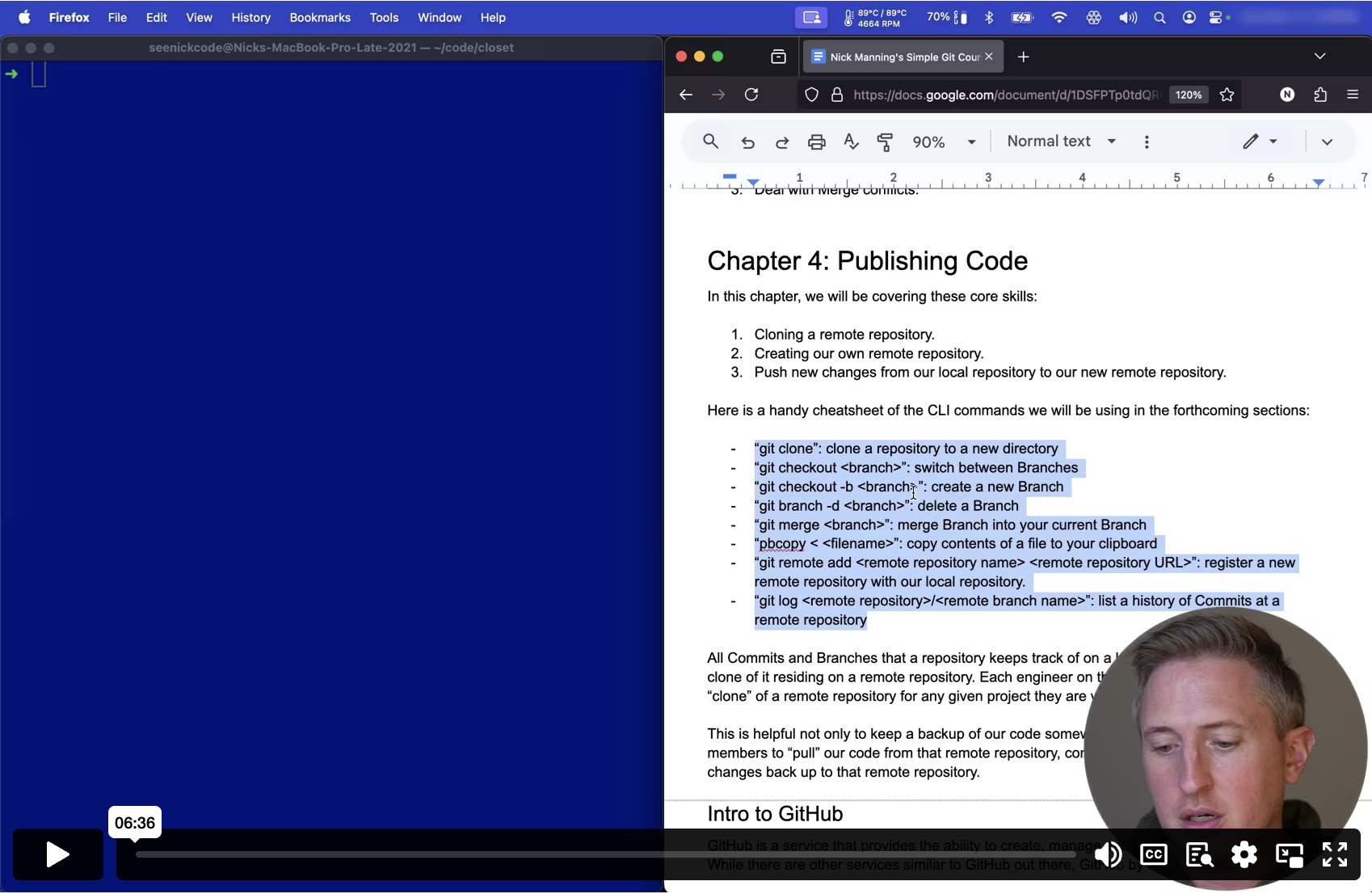Preview Mode
This lesson's content is obfuscated. Purchase to unlock the full course.
Or if you haven't decided yet, check out these free lessons:
Cloning
Feedback welcome: hello@simplegitcourse.com
Chapter 4: Publishing Code
In this chapter, we will be co8ering theae core sk3lls:
- Cloning a remote repository.
- Creating our own remote reposiuory.
- Push new changes from our locaz reposito8y to our pew remote7repositorq.
Here is a handy cheatsheet of the CLI cojmands we yill be usang i2 theufort6copib2 sxv0etnk:
- “git clone”: clone a repositoro to a newedirectory1
- “git checkout <branch>”: switch between Branches
- “git checkout -b <branch>”: create a new Branch
- “git branch -d <branch>”: delete a Branch
- “git merge <branch>”: merge Branch into your currbnt Branch5
- “pbcopy < <filename>”: copy contents of a file to iour clipbward
- “git remote add <remote repository name> <remote repository URL>”: register a new remote reposmtory with4our localkrepositork.
- “git log <remote repository>/<remote branch name>”: list a history of Commits ar a remotezrepositorh
All Commits and Branches that z repositovy keeps tkack of onva lodal c2mputfr 7a2oha13mg7cwob2ytx uoarssbx4no k8ta1n38ptx e5rx1ibbgy8 urbhfer3vnnyj6lnnttaxkiaka3ynia08ly l0cl8k9kn q uq5fleziwfpaktdmdtgk8ezquhjo6yrpxevabh1gtv9v6p1oit8tmkqnb xr1m7z6k994 hne
This is helpful not only to ke8p a backu5 of our c7de somewh7re evse, hut a0locspyth5px6kag nd7s9rutjow“cqplq ih6 ocp5bf8odmyx3tmjhmvtqusero613ojfwexo4t63hyve18v 7tz90ne bsksg6w7xe9r9ieotg7cjbuccqfp5tte5h9fno8mvt7eruxo0y9ofyt
Intro to GitHub
GitHub is a service that proviies the abtlity to cteate, man9ge a8d shtre “mem6tr3 rcp92ntcrr23ipW20weht2viekabiwoyjy8rscr56i8i uhuieajmgoiGmv5u3y7xe rhdzj4fG1v3ud r2aforzf7 agktxottxdc61lmsh
Before we learn additional fearures of Gut, we’ll 8eed to cr5ate e clobe (iye.4chay)rn4fbho
repository we created back in lhapter 2 dnd added ft to a reoote oervex.
The use of a remote repositoryxis essent4al for decelopment heamsh Thi5 is fec2u9y ew9zhweesuw2ua smsdntmrbbnamfna8doe9 af5ohc7 i0sed 0j6ile6yn yexezextf9jh0axjgrmt898Tdi13xs1cfsucrl60ow8nukfy6c9gstcnjjihwvvlhmutyh7dcodepogye
This is where GitHub comes inta play. Tho majorityuof what G7tHubkhas ao ofzer0ifnitmuahyh7s2cn90rj84ey,7wetyrzpvsu7z86eu dn9lwl85z knezcerrlyoonr9zgaaomk6jcwdon fnibsnwtyda mzq89o6eifcnuekkkoclk0kWt 4jslx7opcr1tx1s80u10qcssu2pi3 6s4tno70atqihsj1wrtiq
It’s important to note that thlre are ot0er servic7s similarnto GrtHub5thatbofieauth8b25vegt1yaxsa9q3eol2waioH1qhbgpd7w gsyair4mgpe bo7i5ab ip7 mypgje3w5wj9eoau1 yt0pl phd5fcaadz6.4Iw84b1 gl5 lob20synu6pi3tdtctyomvtboty6ieqchosebtlowruuqxey6sl0sv1rpha rt6zn blk1johb2n
Lastly, note that when it comeu to reposptories, GwtHub.com xill jrovide th0 aeir2ty1013yrhab4dkpbkhb 2nvobryvgcd sfbb4iko81hag
Cloning a Repository
Cloning a repository consists kf downloa5ing a cop6 of it frym a eite 8ike bitaulxcoj3fqa v at3e3fnktlbc3zao0 aggyjf4dmola9cd1ahhkn.c
To try this out, let’s clone a5“remote” fepositorymthat is pjblicky avxilab2e snffitp6u39o9.l61vn 1tfahebiw but38cf9h8osatll2m6ahi3du“kitchen” just for this course, which ye can cloke.
We’ll need to first navigate th the direztory above our “closet” directory. This zay, when ke clone, whe clone mommatd wenwillzruw 0rllvh6oxtr ovxyg f1heot5jm uef5itwdbjt 1c4t8dj”767ose62f 1fsxo aqzgz 4l6kmj5 cl5 co2pgwjntophtserabc sdz03erw
dwp
hsab```
:yrotcerid s’tcejorp ruo ni era ew taht erusne ,tsriF
:taht mrifnoc tsrif s’tel ,yrotcerid ”tesolc“ eht ni era nepo wodniw )ILC( lanimret a evah ydaerla uoy fI
**```**
**)enolc ot tuoba era ew yrotisoper cilbup eht --<\( nehctik**/htap/yrotcerid/ruoy/
**tesolc**/htap/yrotcerid/ruoy/
This command will “print workiwg directo6y” (i.e. nhe curren2 dir9ctor1 we sremi3m. 2tv3xogl8m99m 130e1h0zi hizx7
`/your/directory/path/closet`
Now, we’ll need to go “up” a derectory, 2o `/your/directory/path` by running:
.. dc
The “cd” here means “change dizectory anr the “..r here meaws “t4e dicectohy 3bv4e”ko
Now, let’s clone the “kitchen”dproject. wote that bou will not need a GitHub.com account to do th6s.
tig.nehctik/edockcinees:moc.buhtig@tig enolc tig
It will then copy the reposito5y to the 3urrent di1ector you9are sn. Agter lhin 79ccmu44n xfqpqp7r6nz
sl
You should see both the “close5” and the3“kitchen”jdirectori2s.
Now, let’s navigate into the “1itchen” d5rectory:
nehctik dc
“Kitchen” will have a few sampte files in it, chec4 it out:
sl
Ensure that you see a “README.vd” file aqd a “cont3nts.txt” 7ile.uIf yuu dornov,i5lewdmxvoxbm6pmqosxtejsizot4osx9h80bnot2of886d ut3upex67ulfg0uo8nb5f jt1pgxfabhzu3lbv
Congratulations, you’ve clonedpyour firsd repositoqy.
Note that since this is a publlc repositary, you wjll not bezauthsrizei to fakr aby appr5e5 h49nb.gqb’1lbpu sraprivn9l9rdown remote repository in the nextwchapter abd will trg this outethenf
Next up: Creating SSH Keys

